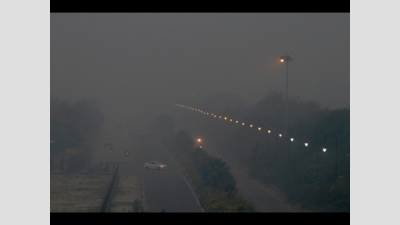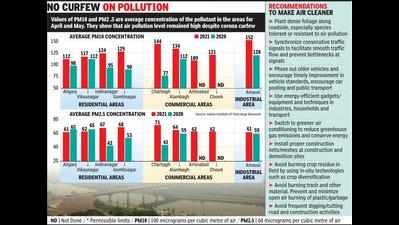- News
- City News
- lucknow News
- Lucknow: Even Covid curfew failed to rein in air pollution
Trending
This story is from June 5, 2021
Lucknow: Even Covid curfew failed to rein in air pollution
Despite restrictions on movement in April and partial curfew in May during the second Covid-19 wave, air pollution levels were above permissible limits in the city in both months, reveals a study by Indian Institute of Toxicology Research (IITR).
LUCKNOW: Despite restrictions on movement in April and partial curfew in May during the second Covid-19 wave, air pollution levels were above permissible limits in the city in both months, reveals a study by Indian Institute of Toxicology Research (IITR).
The ‘assessment of ambient air quality of Lucknow city: pre-monsoon 2021 report’ was released by the CSIR institute on the eve of World Environment Day.
Track the pollution level in your city
The reason is that while many preferred to stay indoors, vehicles continued to ply to provide health services.There was also a mad rush of people for hospital care, besides increase in crematorium fires due to surge in Covid-19 deaths. Other major contributors include domestic cooking, baking/firing in hotels, crop combustion and some industries which were operating, said the report prepared by a team of senior scientists.
“The mean values of PM10 and PM2.5 concentration in the air recorded at all locations increased by 26% and 16% respectively as compared to last year. The reason is that last year, it was a complete lockdown during the Covid-19 first wave, but this time, during the second wave, there were limited restrictions in movement in April and a partial curfew in May,” said chief scientist GC Kisku, who led the team.
The report also found that Gomtinagar and Chargbagh were the most polluted localities in the city. Among residential areas, a 24-hour high PM10 concentration of 128.7 micrograms per cubic metre of air was recorded in Gomtinagar followed by Indiranagar (124.5), Vikasnagar (117.3) and Aliganj (111.9).
Similarly, PM2.5 concentration was highest in Gomtinagar with 68.2 micrograms followed by Indiranagar (67.6), Vikasnagar (62.5) and Aliganj (60.7 micrograms).
Among commercial areas, the highest average PM10 concentration of 143.8 micrograms was recorded in Charbagh followed by Alambagh (133.9), Chowk (121.1) and Aminabad (109.8 micrograms). Similarly, PM2.5 concentration was also highest in Charbagh, with 71.1 followed by Alambagh (64.5), Chowk (62.5) and Aminabad (62 micrograms).
The industrial area of Amausi also recorded high PM10 and PM2.5 values of 152.5 and 61.5 micrograms respectively.
The report said that the concentration of gaseous pollutants, SO2 and NO2, was well below the prescribed NAAQS limit (80mcg/m3) at all locations, but higher in comparison to last year.
“High level of air pollutants and their effects on human health are serious issues. To resolve the issue, a comprehensive study is required with respect to present status of different pollutants and their trends, sources of pollutants and public health risk assessment for future planning on safer urban areas,” the report said.
The ‘assessment of ambient air quality of Lucknow city: pre-monsoon 2021 report’ was released by the CSIR institute on the eve of World Environment Day.
Track the pollution level in your city
The reason is that while many preferred to stay indoors, vehicles continued to ply to provide health services.There was also a mad rush of people for hospital care, besides increase in crematorium fires due to surge in Covid-19 deaths. Other major contributors include domestic cooking, baking/firing in hotels, crop combustion and some industries which were operating, said the report prepared by a team of senior scientists.
The monitoring of nine locations—four each residential and commercial and one industrial—by IITR found that concentration of fine and superfine pollutants PM10 and PM2.5 was higher than permissible limits, which are 100 micrograms for PM10 and 60 micrograms for PM2.5, set by National Ambient Air Quality Standard.
“The mean values of PM10 and PM2.5 concentration in the air recorded at all locations increased by 26% and 16% respectively as compared to last year. The reason is that last year, it was a complete lockdown during the Covid-19 first wave, but this time, during the second wave, there were limited restrictions in movement in April and a partial curfew in May,” said chief scientist GC Kisku, who led the team.
The report also found that Gomtinagar and Chargbagh were the most polluted localities in the city. Among residential areas, a 24-hour high PM10 concentration of 128.7 micrograms per cubic metre of air was recorded in Gomtinagar followed by Indiranagar (124.5), Vikasnagar (117.3) and Aliganj (111.9).
Similarly, PM2.5 concentration was highest in Gomtinagar with 68.2 micrograms followed by Indiranagar (67.6), Vikasnagar (62.5) and Aliganj (60.7 micrograms).
Among commercial areas, the highest average PM10 concentration of 143.8 micrograms was recorded in Charbagh followed by Alambagh (133.9), Chowk (121.1) and Aminabad (109.8 micrograms). Similarly, PM2.5 concentration was also highest in Charbagh, with 71.1 followed by Alambagh (64.5), Chowk (62.5) and Aminabad (62 micrograms).
The industrial area of Amausi also recorded high PM10 and PM2.5 values of 152.5 and 61.5 micrograms respectively.
The report said that the concentration of gaseous pollutants, SO2 and NO2, was well below the prescribed NAAQS limit (80mcg/m3) at all locations, but higher in comparison to last year.
“High level of air pollutants and their effects on human health are serious issues. To resolve the issue, a comprehensive study is required with respect to present status of different pollutants and their trends, sources of pollutants and public health risk assessment for future planning on safer urban areas,” the report said.
End of Article
FOLLOW US ON SOCIAL MEDIA












